Full Text:Sustainable Development of Transport in China
Sustainable Development of Transport in China
The State Council Information Office of
the People's Republic of China
December 2020
Contents
Preface
I. A New Path for Transport in the New Era
II. China's Growing Strength in Transport
III. A Key to Poverty Alleviation and Moderate Prosperity
IV. Modernization of Transport Governance
V. Building a Global Community of Transport for All
VI. Future Prospects for China’s Transport
Conclusion
Preface
Transport is an important service industry – a basic, leading and strategic sector of the economy underpinning sustainable development.
Since the founding of the People's Republic of China in 1949, and particularly since the beginning of reform and opening up in 1978, under the leadership of the Communist Party of China (CPC), China has followed a strategy of coordinating the development of its transport industry with its economy and society, and ensuring harmony between the transport system and the natural environment. Based on a self-reliant approach, China has made a great effort to create a transport industry that fully responds to public needs. Remarkable results have been achieved, and a once-backward transport industry with a weak base has been hugely improved, providing strong support for economic and social development and creating an outstanding transport system with Chinese characteristics.
Since the 18th CPC National Congress held in November 2012, under the guidance of Xi Jinping Thought on Socialism with Chinese Characteristics for a New Era, China has made historic progress in its transport system. The industry has entered a golden period characterized by infrastructure improvements, better services, and high-quality transformation and development. China leads the world in terms of the scale of its transport infrastructure. Its transport service and support capacity has steadily improved, its capacity for technological innovation has markedly strengthened, and the modernization of management has made huge steps forward in this sector. As a result, the public now enjoys higher-quality travel experiences, and China is on the way to becoming a world leader in transport.
The world today is undergoing levels of change unseen in a century, and the future of all countries is linked in ways that are unprecedented. In this context, the role of transport in enhancing connectivity and people-to-people bonds is growing in importance. As a major country that shoulders its responsibilities, China is committed to implementing the United Nations 2030 Agenda for Sustainable Development. It takes an active part in global transport governance, and looks to strengthen international exchanges and cooperation, so as to contribute Chinese wisdom and strength to sustainable development throughout the world and help to build a global community of shared future.
The Chinese government is publishing this white paper to provide a full picture of China's achievements in the field of transport, and to share with the international community China's strategy and activities in building a sustainable transport system.
I. A New Path for Transport in the New Era
China's transport industry has followed a new path to keep up with the new development dynamic, serving high-quality domestic development and high-standard opening up. China is taking advantage of a period of golden opportunities to improve infrastructure, upgrade services and make transformation in order to build a comprehensive transport system that is intelligent, safe, and green.
1. Building the Transport System That the People Need
China is committed to satisfying public needs and serving public interest in developing its transport industry. In the new era, China adheres to a people-centered approach to governing and developing the sector based on public collaboration and participation for the benefit of all. It is dedicated to building the transport system that the people need.
– Public participation. China must concentrate its efforts on solving the most pressing, immediate transport issues that concern the people the most, encourage them to become involved in the governance of transport, and boost their initiative and creativity.
– Benefit for all. China should guarantee equitable and efficient access to basic public services in urban and rural areas, and ensure that transport development is sustainable and beneficial to all.
– People-centered development. Public satisfaction is the ultimate criterion for evaluating government work. In the light of public expectations in the new era, China focuses on building a high-quality transport industry through supply-side structural reform, meeting the transport needs of diverse groups, and bringing the people a stronger sense of gain, happiness and security.
2. Leading Economic Development
A nation and its economy can only be strong when its transport system is well-developed. Transport plays a leading role in economic and social development. China ensures that it can play this role to the full by always planning for the future and maintaining an appropriate pace of growth.
– Priority in planning. Priority has been given to transport when implementing strategies for coordinated regional development, including the Beijing-Tianjin-Hebei Region, the Yangtze River Economic Belt, the Yangtze River Delta, and the Guangdong-Hong Kong-Macao Greater Bay Area, and when facilitating major programs such as poverty eradication, rural revitalization, and new urbanization.
– Future-oriented planning. In formulating comprehensive transport plans, and in building a comprehensive and multidimensional transport network, China has adopted future-oriented plans for infrastructure construction to accommodate new industrialization, information technology, urbanization, and agricultural modernization. The goal is to bolster economic and social development now and in the future.
– The leading role of transport. Transport should play a key role in making the best use of land, facilitating cross-region industrial transfer, improving the spatial layout of urban areas, and promoting economic exchanges and trade. China gives full play to the leading role of new internet-based transport business forms in fostering driving forces for economic development and accelerating the rise of new forms of economic activity.
3. New Development Philosophy as Guide
Implementing the vision of innovative, coordinated, green, open, and shared development is the key to developing China's transport industry in the new era. China works to steer the future of transport with the new development philosophy, updating concepts, adopting new approaches, resolving difficulties and boosting strengths.
– Building a modern comprehensive transport system that is safe, convenient, efficient, green and economical. China aims to build a high-quality rapid transit network, an efficient regular artery network, and an extensive basic service network. China is moving faster in building a comprehensive and multidimensional and interconnected transport network that traverses the whole country and connects it to the world.
– Advancing supply-side structural reform in transport. China reduces the structural, institutional, technical, administrative, and service costs of transport, helps logistics industry to reduce costs and increase efficiency, so that transport can play the principal role in boosting the development of the logistics industry.
– Improving the business environment. In promoting law-based governance of the country, China properly defines the fiscal powers of the central and local governments in the field of transport and their responsibilities for expenditure, further streamlines administration and delegates powers, strengthens regulation, and provides better services to the transport industry. Efforts have been made to build a new supervision mechanism based on credit, and provide a business environment that is based on market principles, governed by the rule of law, and aligned with international standards.
– Strengthening drivers of development. China encourages and regulates new forms of business in the transport industry, accelerates the transformation of growth drivers, and strives to establish a multilevel transport service system offering high quality and diverse options.
4. Reform and Opening Up as a Driving Force
Further reform and opening up provides a powerful driving force for steady progress in the transport industry. China perseveres with its reform to build the socialist market economy, and creates stronger synergy between a well-functioning market and an enabling government, so as to unleash the productivity of the transport industry.
– Making the transport industry more market-oriented. China ensures that the market plays the decisive role in resource allocation, and that the government plays its role better. The state has lifted restrictions on access to the transport market and is promoting changes for higher quality, efficiency and impetus. It is crucial to rely on the market to tackle insufficient development while better playing the role of the government in addressing unbalanced development, so as to improve the transport market and increase the vitality of the transport industry.
– Pursuing high-standard opening up. China pursues development with its doors open wide and encourages "bringing in" and "going global" in transport development. Focusing on facilitating cooperation under the Belt and Road Initiative, China makes great efforts to promote land, sea, air and cyber connectivity, and coordination of policies, rules and standards, so as to ensure higher-level connectivity with other countries and facilitate international transport.
5. Innovation as Support
Innovation is a prime mover in transport development. With technological innovation as a locomotive, China promotes innovation in management, institutions and culture, improves its innovation system and environment, and optimizes its human resources in support of the transport industry.
– Increasing the durability of the transport system through upgrading infrastructure construction and maintenance technologies. China strengthens the disaster-resistance, early warning and monitoring capacity of its transport infrastructure, and improves its engineering technologies for high-speed rail, expressways, mega bridges and tunnels, deep-water ports, large airports and other projects.
– Advancing the digital economy and the sharing economy through developing intelligent transport. China fosters a new transport system by promoting coordinated innovation in business models and forms, products, and services, and improving the efficiency of comprehensive transport networks.
– Raising the quality of the transport industry through digital, internet-based, intelligent and green technologies. China endeavors to seize the historic opportunities provided by a new round of global technological revolution and industrial transformation, and use new technologies and new business models and forms to promote sustainable development of its transport industry.
II. China's Growing Strength in Transport
In the new era, China is accelerating the high-quality development of its transport industry – it is seeing consistent progress in infrastructure construction, marked improvements in transport capacity, quality and efficiency, stronger technological support, greater accessibility and convenience, and more efficient freight transport. China is building up its strengthen in transport.
1. Creating a Comprehensive Infrastructure Network
China has taken advantage of a key window of opportunity to optimize the configuration of transport infrastructure and build it into a comprehensive network. The country has advanced supply-side structural reform in transport by bringing into service a group of passenger and freight hubs. The scale, quality and coverage of the comprehensive transport network have been significantly increased.
Forming a basic network for comprehensive transport infrastructure. By the end of 2019, China had a total of 139,000 km of rail track, of which high-speed lines represented 35,000 km, and a total of more than 5 million km of highways, of which expressways represented 150,000 km. The country had 23,000 operative berths, including 2,520 berths of 10,000-tonne-class or above, and 127,000 km of navigable inland waterways. There were 238 certified civil airports throughout the country. The long-distance oil and gas pipelines totaled 156,000 km with better connections achieved. The total network length of postal and express delivery services approximated 41 million km; every township had a post office and every village was provided with postal services. A comprehensive and multidimensional transport network has been put in place to give strong support to the sustained, rapid and healthy development of society and the economy.
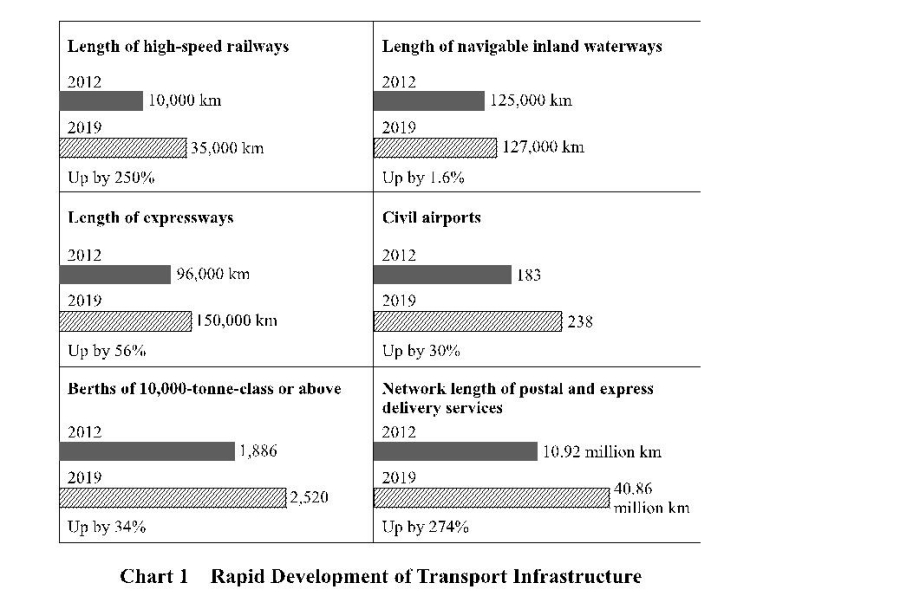
Connecting the main transport corridors. The main transport corridors will be further expanded and connected to ensure China's territorial and energy security, and strengthen economic and political connections between regions. The state has devised ten vertical and ten horizontal transport corridors. Economic belts and city clusters are thriving along the transport corridors between Beijing and Shanghai, between Beijing and Guangzhou, along the Yangtze River and the coastlines, and near the ports in the Yangtze River Delta and Pearl River Delta and along the Bohai Sea Rim. They are becoming the most economically dynamic and populous areas in the country. Two thirds of the cities and 80 percent of the GDP of the Yangtze River Delta are concentrated along the high-speed transport corridors between Shanghai and Nanjing, and between Shanghai and Hangzhou. A rapid intercity transport network featuring high-speed railways, intercity railways and high-grade highways has been put in place in the Guangdong-Hong Kong-Macao Greater Bay Area.
A trunk network of gas pipelines is improving with the capacity to transmit gas from west to east China, from Sichuan to east China and from Shaanxi to Beijing, and to bring gas from offshore. Coal logistics corridors are better configured, and a railway corridor for energy transport running across the country has taken shape. The main logistics corridors for grain have been connected, and the container volumes of unprocessed grain, bulk grain and refined grain have increased significantly, along with improved efficiency in grain logistics. Flow of people and goods is more convenient between regions. An open and comprehensive transport network that crosses the whole country and connects with the world has taken shape.
Building integrated transport hubs. By giving full play to the hub economy and actively fostering new drivers of growth, China has promoted the integration of transport, logistics, and information with society and the economy. Considering the national urban configuration, the country has built international transport hubs in Beijing, Shanghai and Guangzhou, and created more transport hubs at national and regional levels. Highlighting the need for integrated transport terminals, a group of such projects have been completed, such as the Beijing Daxing and Shanghai Hongqiao hubs, integrating airport transport seamlessly with high-speed and standard rail, and urban passenger transport.
The configuration of freight terminals and logistics parks has been optimized for multimodal and multilevel transport. A number of modern logistics hubs, such as Yangshan Port in Shanghai and the railway inland port in Zhengzhou, have helped to improve the transshipment capacity, enhance multimodal transport, and create a comprehensive transport system. The integration of various transport methods at these hubs provides strong support for optimizing the economic structure and modernizing the economic system.
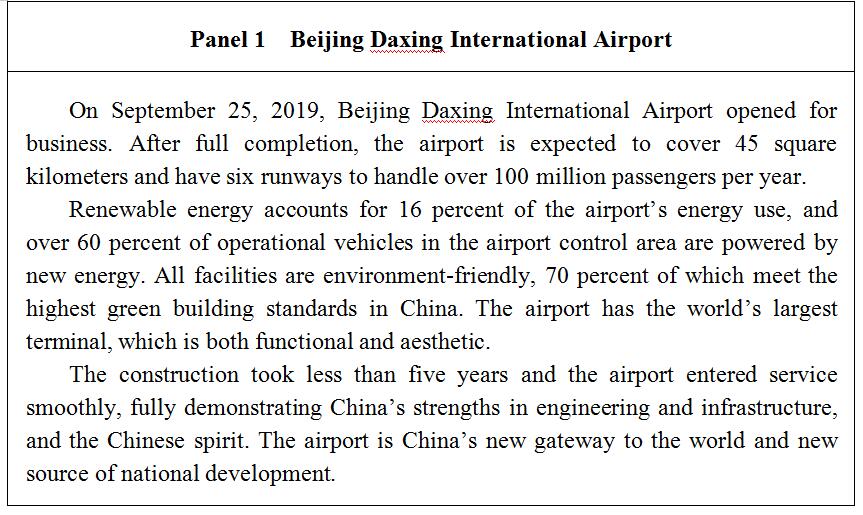
Strengthening systematic planning for urban transport infrastructure. By the end of 2019, the total length of urban roads across the country was 459,000 km, the road area per capita 17.36 sq m, the road network density in the urban built-up areas was 6.65 km/sq km and the road area ratio 13.19 percent. The government has strengthened planning for a comprehensive urban transport network and improved effective transport connections between cities and neighboring areas.
With a concept of "narrower roads and a denser network", China has built an urban road network featuring a reasonable composition of expressways, arterial roads, sub-arterial roads and branch roads friendly to green travel. The transport authorities have improved road space allocation to fully ensure the needs of green travel and regulated the provision of traffic safety and management facilities. The country has carried out campaigns to clear up sidewalks and build bike paths to improve the environment for green travel.
2. Optimizing Transport Capacity and Quality
China has made all-round improvements to the quality of transport. The rapid growth of Internet Plus Transport and other new business models has offered more equitable access to more diversified services of higher quality, facilitating the movement of people and goods, and strengthening the accessibility and support functions of transport. Transport is playing a stronger role in supporting the nation's economic and social development, and in promoting investment, stimulating consumption, and sustaining growth.
Enhancing freight transport capacity. China is one of the busiest freight hubs in the world. The increasing demand for freight capacity requires China to accelerate multimodal transport, create efficient and innovative transport links such as rail-highway, air-rail, rail-waterway and river-sea transport, ship-to-ship transfer, and roll-on/roll-off shipping.
China has also implemented programs to raise railway transport capacity, upgrade waterway transport, and regulate highway freight transport. The freight transport structure has been optimized, overall transport efficiency has improved, and logistics costs have been lowered. A marked decrease has been seen in transport pollution. The construction of pipelines for crude oil, refined oil and natural gas is accelerating. The proportion of rail transport in total freight transport is increasing. Visible results have been achieved in shifting more freight transport from road to railway. The cargo throughput and container throughput in China's ports both rank first in the world. Express delivery continues to flourish, and has led the world for the past six years. Substantial growth in transport service capacity has accelerated progress in reducing costs, increasing efficiency, and upgrading the logistics industry.
Meeting the public's expectation for quality travel. Passenger transport is becoming more professional and personal, meeting the public's expectation for a better, faster, more convenient, more comfortable, and satisfying travel experience. With road transport as the base and high-speed rail and civil aviation as the direction of future development, the transport service structure is improving. The trend is for passengers on middle- and long-distance journeys to shift from highway travel to high-speed rail and planes. By the end of 2019, 12 billion trips had been made on high-speed rail, and its share of total rail passenger transport had risen from 4.5 percent in 2007 to 65.4 percent.
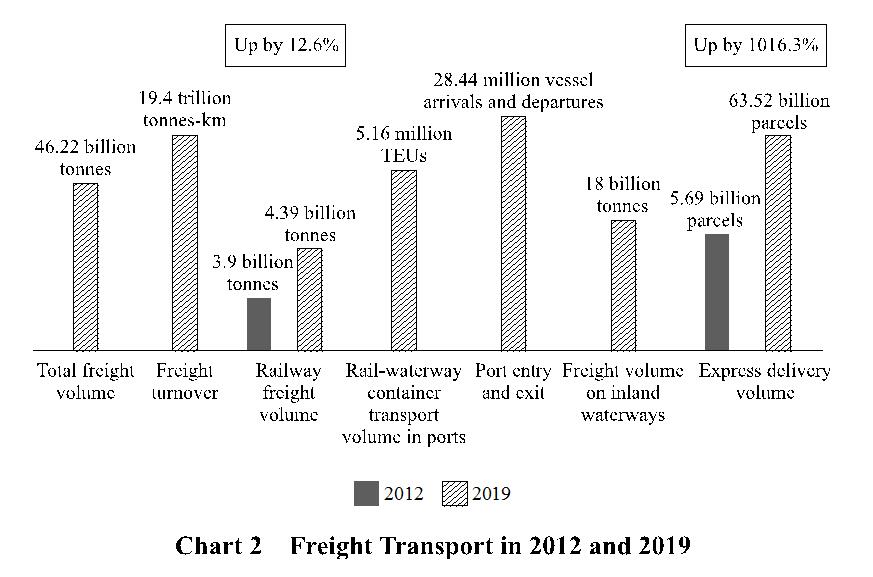
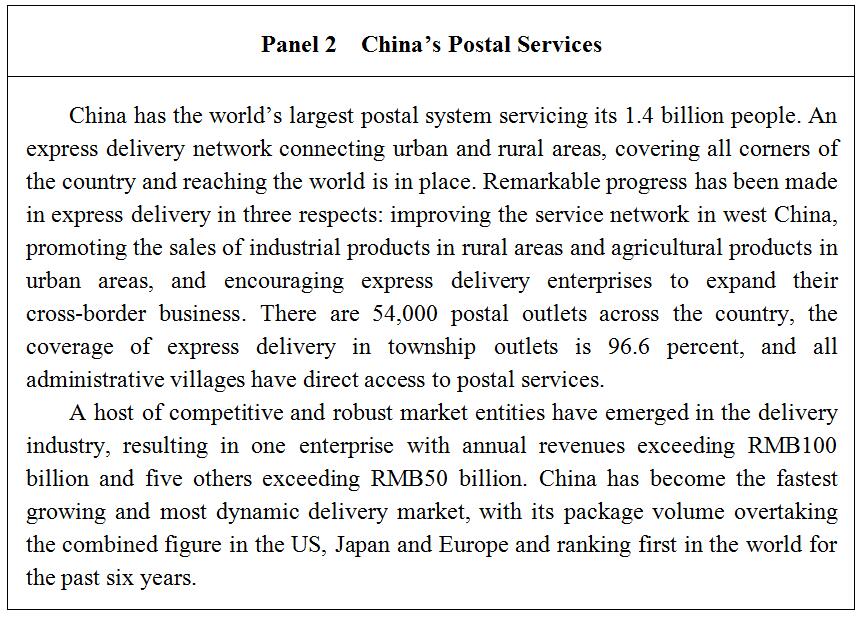
The transport capacity and service during the Chinese New Year holiday, National Day holiday, and other travel peaks have significantly increased. People can now take a trip whenever they want, and enjoy quality and professional service that makes travel a comfortable and satisfying experience.
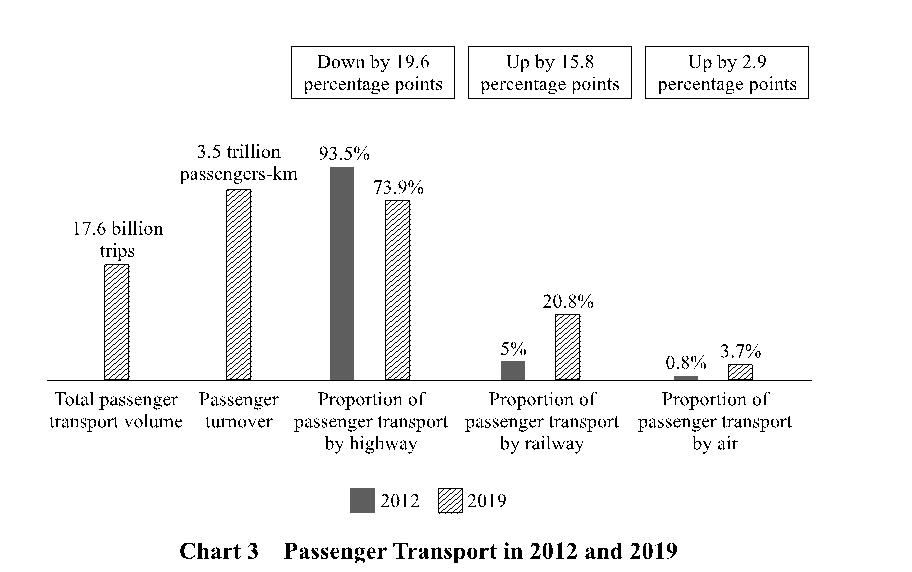
Prioritizing the sustainable development of urban public transport. Modern cities aspire to provide high-quality public transport, and take effective measures to strengthen urban traffic management and enhance the life quality of urban citizens. Great efforts have been made to improve urban rail services. By the end of 2019, a total of 40 cities had opened urban rail transit lines, with 6,172.2 km of track. While the role of rail transit is increasingly visible, the number of people using public transport for travel is also growing, and the level of comfort is improving.
Rapid development has also been seen in non-motorized transport. More than 70 cities have released administrative measures to regulate bike-sharing, and over 360 cities provide bike-sharing services. Public transport offers convenient travel by meeting the public's diverse travel needs.
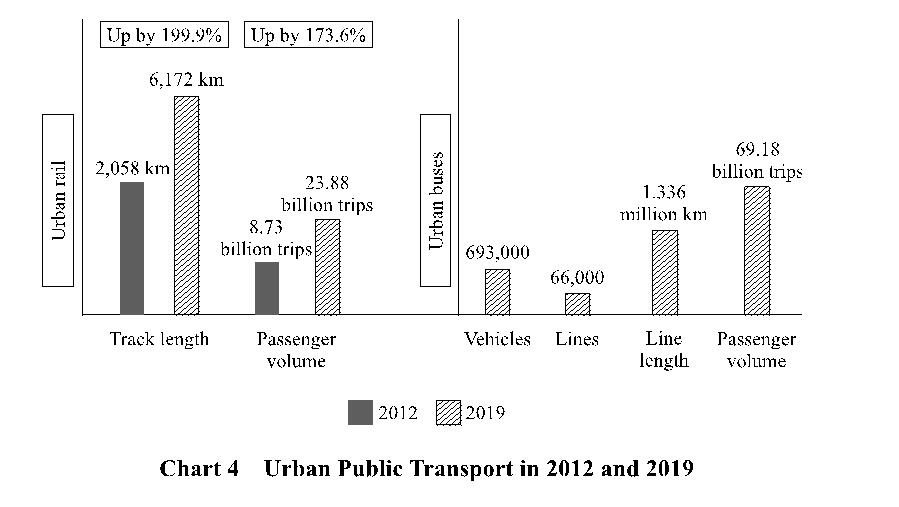
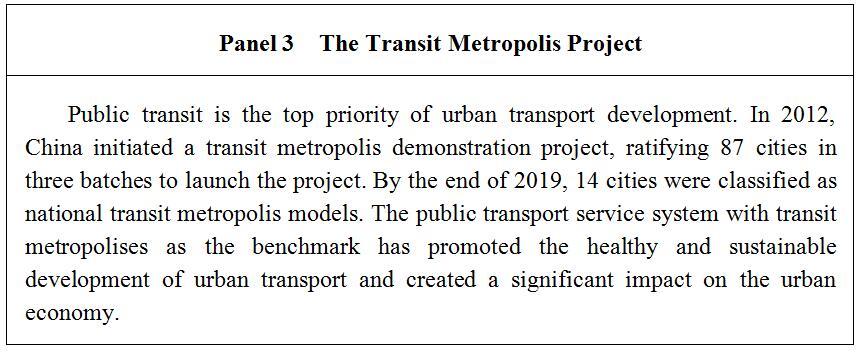
Ensuring equal access to basic public services. To promote social harmony, the Chinesegovernment is committed to ensuring equal access to public transport services. Low-fare low-speed trains in remote areas which stop at every small station and have a similar function to buses, serve as a bridge between mountainous villages and cities. These trains provide a convenient public welfare service to people along the line and facilitate their efforts towards a better life.
The nationwide expansion of highway passenger transport and rural logistics has helped to integrate rural and urban areas. By the end of 2019, integration of rural and urban transport had been piloted in 52 counties; 95 percent of urban districts and counties nationwide had achieved AAA ratings in urban-rural transport integration, and 79 percent had achieved AAAA ratings.
Accessible transport provides convenience for people with disabilities, and barrier-free access has been implemented at public transport hubs including train stations, highway service areas, passenger ship terminals, airports, and postal outlets. Further measures are being implemented to provide universal services and help people share in the fruits of transport development.
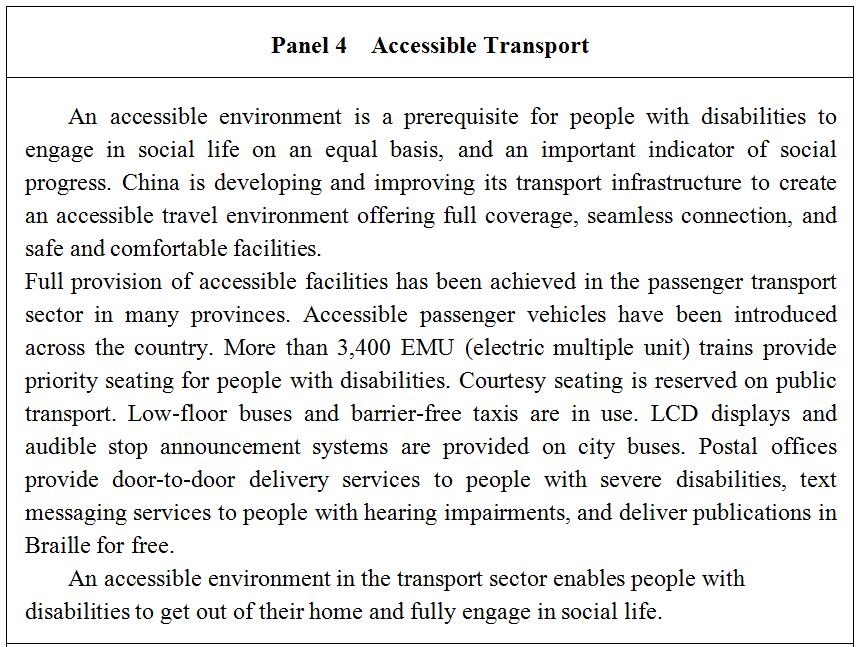
Encouraging new models and forms of business in transport. Internet Plus models in transport are having a profound impact on the way people travel. By the end of 2019, more than 400 cities across the country had online car-hailing services, with daily usage averaging 20 million trips. Bike-sharing has effectively bridged the last kilometer in urban travel, with daily usage averaging more than 45.7 million trips.
The penetration of Internet Plus into freight logistics is accelerating, and inspiring organizational innovations. The 95306 online platform for railway freight services was put in place. In 2019, the online rail freight service handling rate rose to 85 percent. 229 non-truck operating common carriers integrated 2.11 million freight vehicles, improving the utilization rate by 50 percent, lowering the freight transaction cost by six to eight percentage points compared with traditional ways. The integration of the internet and high-speed railway network has seen remarkable results. In 2019, a total of 3.57 billion tickets were sold on 12306.cn, China's official website for booking train tickets. Electronic tickets can be bought at almost all railway stations. China is on the way to achieving full WIFI coverage in high-speed trains and stations. It has also made innovations to roll out services such as online meal booking, wireless charging and intelligent interaction.
By the end of 2019, over 98 percent of the bus terminals at the county level and above offer province-side online ticket booking services. The new online and offline forms of passenger transport such as car-hailing, bike-sharing, and car-sharing services, and new forms of business such as facial recognition check-in at railway stations, paperless boarding at airports, drone delivery, contactless delivery, intelligent parking, and customized passenger transport services have brought convenience to people and injected fresh momentum to economic growth.
Supporting major strategies for regional development. China has strengthened the transport configuration to support and serve the strategy to coordinate the development of the Beijing-Tianjin-Hebei Region, the Yangtze River Economic Belt, the Guangdong-Hong Kong-Macao Greater Bay Area and other regions. The country has accelerated to build multi-junction transport matrices for world-class city clusters, and a first-class comprehensive transport system in the Xiong'an New Area. Efficient connections between trunk, intercity, suburban and urban rail have been achieved, with a focus on facilitating Beijing-Tianjin-Hebei integration.
In its efforts to systematically manage major waterways, China has mitigated the traffic bottleneck along the Three Gorges Dam, improved the function of the Yangtze River as the golden waterway, and endeavored to build a transport corridor along the Yangtze River Economic Belt. To create a modern and comprehensive transport network in the Guangdong-Hong Kong-Macao Greater Bay Area, the country has opened up transport corridors in the east, west and north of Guangdong connecting the Greater Bay Area with surrounding provinces and regions, and aimed to build an international overland transport corridor linking the pan-Pearl River Delta with the Association of Southeast Asian Nations (ASEAN).
To support the Hainan Free Trade Port, China has built a multi-junction, province-wide transport matrix of railways, intercity rail, and main highways in Hainan, focusing on the Haikou-Chengmai-Wenchang Economic Integration Circle and the Greater Sanya Tourism Economic Circle. To promote better and integrated transport in the Yangtze River Delta, the country has built a multilevel, well-connected transport network with Shanghai, Nanjing, Hangzhou, Hefei, Suzhou, Wuxi, Changzhou and Ningbo as the junctions.
In line with the need for eco-environmental conservation and territorial space development in the Yellow River Basin, China has coordinated the development of the transport corridors, hubs and network in the river basin. Targeted transport measures in various regions have been designed to support their respective strategies.
3. Moving from Follower to Leader in Transport Technology
China's capacity for innovation in transport has strengthened – it possesses self-developed core technologies, and has made major breakthroughs in transport infrastructure and equipment. Capacity for sustainable development is growing. China is making steady progress from a follower to a leader in transport technology.
World-leading mega-projects. China leads the world in technology for railways at high altitudes and in extremely low temperatures, and for high-speed and heavy-haul railways. It has solved the most challenging technical problems confronting highway construction in difficult geological conditions such as plateau permafrost, expansive soil, and desert. It also leads in core technologies for building deep-water offshore ports, improving massive estuary and long waterways, and building large airports.
The Beijing-Guangzhou High-speed Railway, the longest high-speed rail line in the world, has been completed. The Lanzhou-Urumqi High-speed Railway has the world's longest line that has been built at one go. The Harbin-Dalian High-speed Railway, the world's first high-speed rail line operating at low temperatures in winter is open to traffic. The Datong-Qinhuangdao Heavy-haul Railway ranks top in the world in terms of annual transport volume. The Xueshan No. 1 Tunnel, the world's highest of its kind, built in Golog Tibetan Autonomous Prefecture, Qinghai Province, has been opened to traffic. The section of the Sichuan-Tibet Railway between Ya'an and Nyingchi is under construction.
Other notable mega-projects include the Hong Kong-Zhuhai-Macao Bridge, the Xi’an-Chengdu High-speed Rail cutting through the Qinling Mountains, the container terminal at Yangshan Port, the automated container terminal at Qingdao Port, and the deep-water channel improvement project in the Yangtze River Estuary.
China leads the world in the total length and number of highway bridges and tunnels in service and under construction. It has seven of the ten longest cable-stayed bridges, six of the ten longest suspension bridges, six of the ten longest cross-sea bridges, and eight of the ten highest bridges in the world.
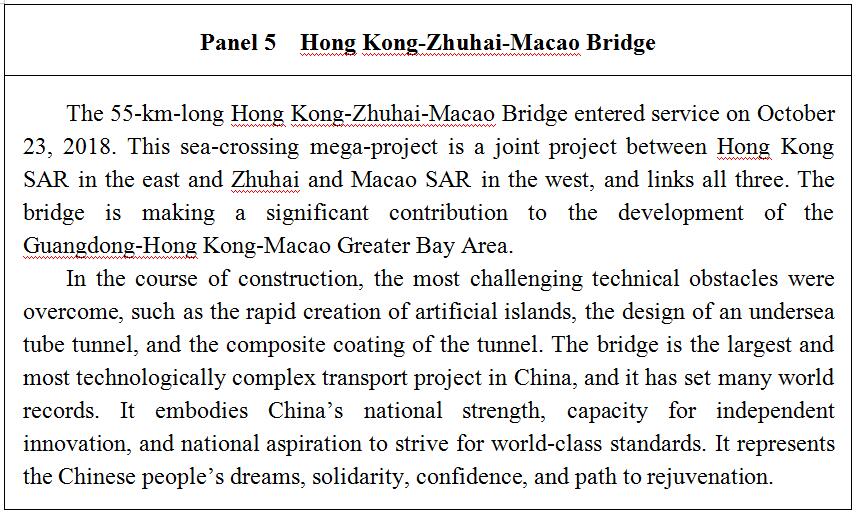
Major breakthroughs in transport equipment technology. Aiming to develop cutting-edge core technologies, China has substantially improved the level of its independent research in key transport equipment technology. China has set a world record by successfully testing its self-developed Fuxing EMU trains running at 420 km/h in intersection and coupled operations. The Fuxing EMUs have been running at 350 km/h – the highest operating speed in the world – on the Beijing-Shanghai High-speed Rail, the Beijing-Tianjin Intercity Rail and the Beijing-Zhangjiakou High-speed Rail. China became the first in the world to realize autopilot on trains running at a speed of 350 km/h. 600 km/h prototype maglev trains and high-speed free gauge trains running at a speed of 400 km/h that can change tracks and are capable of making international trips have rolled off the production line.
Major breakthroughs have been achieved in tunneling technology – earth pressure balance, hard rock, and slurry shield machines with the world's largest operating diameters have been developed. The fuel-efficient and new energy vehicle industry is prospering, keeping abreast of the latest international advances. The manufacturing technologies for special marine engineering machinery vessels and complete sets of large automated and specialized container handling equipment rank top in the world. China has also made innovative breakthroughs in 300-meter saturation diving. The C919 large passenger aircraft has made its maiden flight. The ARJ21 regional jet is now in commercial service.
The sorting technology in express delivery is developing rapidly. China leads the world in building ocean-going vessels, high-speed EMU trains, high-power locomotives, and marine engineering machinery. Its burgeoning equipment technology in large aircraft and new-generation intelligent connected vehicles is on the way to becoming a major international calling card for China's manufacturing.
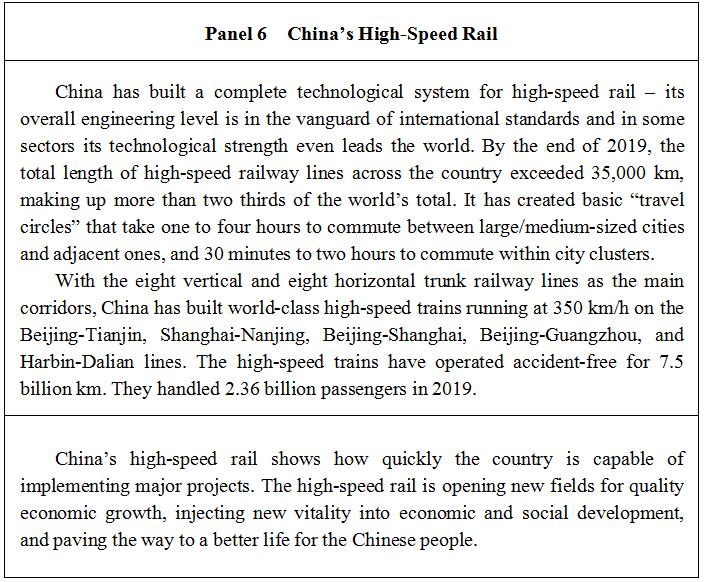
Expedited development of intelligent transport. China is developing transport featuring Internet Plus to fully integrate modern information technology with transport management and services. The country has applied emerging technologies such as 5G, big data, and artificial intelligence to transport infrastructure and equipment, and has made breakthroughs in research and development of intelligent transport. Electronic ticketing and online booking have become increasingly popular in railway, highway, waterway and civil aviation passenger services, the application of IT in transport management has significantly increased. By the end of 2019, 229 airports and major airlines have realized paperless travel.
China has removed all expressway toll booths at provincial borders across the country. Positive results have been achieved in the application of new technologies such as Electronic Toll Collection (ETC) on expressways. By the end of 2019, there were more than 200 million ETC users across the country. Round-the-clock, all-weather and full-coverage monitoring of the road network and information distribution are strengthening.
The BeiDou Navigation Satellite System (BDS) has been applied to 7.6 million vehicles on the road, 33,300 postal and express delivery trucks, 1,369 public service vessels, 10,863 maritime navigation facilities, 109 coastal ground-based augmentation stations, 352 general-purpose aircraft, and three transport aircraft. The Beijing-Zhangjiakou High-speed Rail featuring autopilot is the first in the world to use the BDS. Intelligent highway technologies are further promoted, and intelligent port and shipping technologies are widely used. Intelligent delivery outlets are found everywhere in all major cities, and automated sorting has been adopted by all major distribution centers of express delivery enterprises.
China has released administrative rules on road testing of self-driving vehicles, technical guidelines on the construction of enclosed testing fields for autopilot, and rules on intelligent ships. It has built a test area for unmanned cargo ships and piloted the use of drones in delivery services.
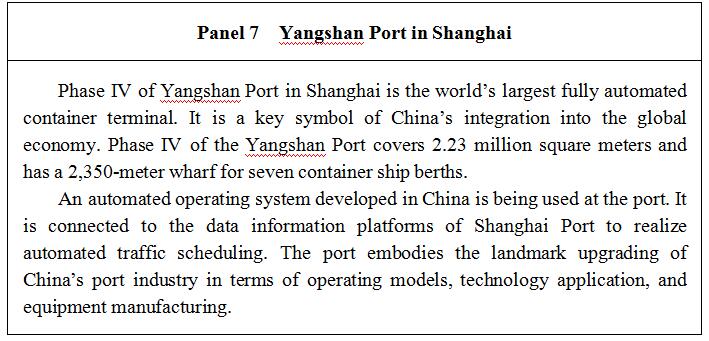
III. A Key to Poverty Alleviation and Moderate Prosperity
Achieving moderate prosperity in China's rural areas – the key for completion of this overall national task – hinges largely on the improvement of the transport network there. China is very conscious of the role of transport in poverty alleviation, and sees it as an important support to all-round moderate prosperity across the country, the modernization of agriculture and rural areas, and shared benefits from reform and development. Therefore, it makes every effort to remove the transport bottlenecks that hinder the development of rural areas, providing a solid foundation for rural people to escape from poverty and move to moderate prosperity.
1. Winning the Battle Against Poverty Through Transport
Poverty alleviation has been raised to the top of the agenda for transport in the new era. The transport authorities have improved the planning and policy system for poverty alleviation, created new work models, and prioritized the planning, funding, coordination and implementation of poverty alleviation-oriented transport projects and measures. Through these extraordinary steps and efforts, China is counting on transport to facilitate its campaign against poverty.
Better planning for transport projects to alleviate poverty. China has improved the top-level design and policy framework of poverty alleviation-oriented transport projects. It has devised strategies, implementation programs, and action plans in this regard, including the Outline of Poverty Alleviation-Oriented Transport Projects in Contiguous Poverty-Stricken Areas (2011-2020), the Plan for Transport-Driven Poverty Alleviation During the 13th Five-Year Plan Period (2016-2020), the Opinions on the Implementation of the Plan to Further Leverage Transport to Support Poverty Alleviation, involving 1,177 counties, cities and districts in old revolutionary base areas, areas with large ethnic minority populations, border areas, and poor areas.
Taking severely impoverished areas as the priority, China has moved faster to upgrade national expressways and national and provincial highways, and prioritized transport projects that provide villages and households with better access to roads. It has worked to renovate and expand trunk and rural roads, improve the quality, safety and environment of transport infrastructure, and leverage local resources through transport.
Breaking new ground in targeted transport-driven poverty elimination. China has intensified coordinated planning in this field by formulating and improving a system in which a five-year plan, a three-year action plan and annual plans operate as a unit. Detailed annual programs are made at the provincial level to ensure the plans are carried out in alignment.
China has increased its effort to help impoverished people access education and build aspirations. In addition to providing them with useful information, knowledge, skills training and technologies, it has also encouraged them to find work on rural road construction projects, and employed workers from poverty-stricken households to carry out road maintenance.
Increasing investment in poverty alleviation-oriented transport projects. The state has steadily increased the central government subsidy as a proportion of transport project investment for impoverished areas. From 2012 to 2020, over RMB1.46 trillion, or 61.3 percent of total road construction funds from vehicle purchase tax, was directed to poor areas, which mobilized another RMB5.13 trillion of social investment. The average contribution from vehicle purchase tax to national expressway projects rose from 15 percent during the 12th Five-year Plan period (2011-2015) to 30 percent during the 13th Five-year Plan period (2016-2020), and the increase in national highways was from 30 percent to 50 percent. Government subsidies from vehicle purchase tax to asphalt and concrete road projects for towns, townships and administrative villages rose to an average of 70 percent or more of project costs.
By optimizing the disposition of central budget investment, vehicle purchase tax, and other funds, China has lent more financial support to ensure the implementation of these policies and projects.
Focusing on severely impoverished areas. The most arduous tasks in achieving moderate prosperity throughout the country are in the rural areas, especially in severely impoverished areas. Therefore, China has underlined the primary role of transport in poverty elimination, and increased support to these locations, giving preference to the "three areas and three prefectures"[ The "three areas and three prefectures" are national-level severely impoverished areas, with harsh natural and economic conditions. The "three areas" refer to the Tibet Autonomous Region, prefectures and counties with large Tibetan populations in Qinghai, Sichuan, Gansu and Yunnan provinces, and the Hotan, Aksu, Kashgar prefectures and the Kizilsu Kirgiz Autonomous Prefecture in southern Xinjiang. The "three prefectures" refer to the Liangshan Yi Autonomous Prefecture in Sichuan Province, the Nujiang Lisu Autonomous Prefecture in Yunnan Province, and the Linxia Hui Autonomous Prefecture in Gansu Province.] when allocating new funds, planning new projects and formulating new measures. From 2016 to 2020, China spent RMB274.6 billion from vehicle purchase tax on transport projects in the "three areas and three prefectures", including RMB78.1 billion on rural road projects.
2. Promoting High-Quality Transport in Poor Areas
Good roads are key to prosperity in all sectors. Aiming to build high-quality rural roads that are properly built, operated, managed, and maintained, China has created a safe and easily accessible transport network that links villages, towns and townships in impoverished areas and connects them with other parts of the country. It has improved passenger and freight transport services in urban and rural areas, and expanded bus services to more villages. The backward nature of transport in poor areas has gone through a complete transformation.
Establishing a comprehensive transport network in poor areas. Inadequate transport infrastructure is one of the most formidable challenges confronting poverty-stricken areas. To resolve this challenge, the state subsidized the upgrading of 17,000 km of national expressways and 53,000 km of national highways, and the building of 2,365 km of inland waterways from 2016 to 2019. By now, almost all county seats in poor areas have access to highways of Grade II or above, with many of the counties having expressways, and some having railways or even airports. A high-grade inland waterway network linking trunk rivers and tributaries continues to improve. Through such efforts, a comprehensive transport network is taking shape in poor areas rapidly, and the gap between in and outside of these areas is shrinking.
Achieving notable results in building high-quality rural roads. Two hundred pilot counties have led the development of high-quality rural roads that are properly built, operated, managed, and maintained. China has strengthened regulation and exercised strict quality control of rural road projects, making seven key pieces of information available to the public: construction plans, subsidy policies, tendering, construction management, quality supervision, fund management, and project delivery and review. The country has improved the configuration of the rural road network, promoted the road chief system nationwide, and enhanced the long-term mechanism for building high-quality rural roads. A five-tiered accountability system has been implemented, clearly defining responsibilities for road management at provincial, city, county, township, and village levels. In the process of reforming public institutions and township government institutions, the rural road management system in counties and towns has also been improved.
The transport departments have strived to increase public satisfaction with rural roads, and promoted the practice of packaging road maintenance contracts with construction projects. The beautiful countryside program has served to improve the environment along rural roads.
Passenger transport resources in urban and rural areas are being coordinated, and new modes of passenger transport are being explored in rural areas. The resources of transport departments, postal agencies, supply and marketing cooperatives, and e-commerce companies have been integrated to improve logistics in poor rural areas.
These measures have achieved solid results, bringing business and funds to rural areas, especially those suffering from poverty.
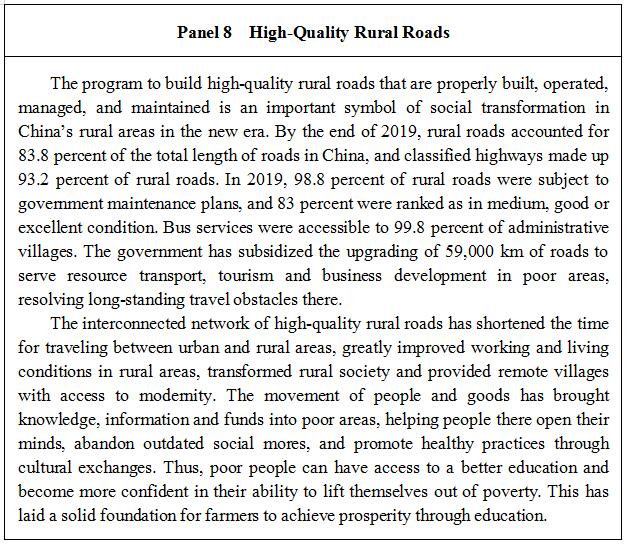
Making travel easier and more convenient. Due to the significant improvement in rural roads, the days in which travelers had to trudge through dust and mud on dirt roads are gone. All towns, townships and administrative villages with feasible conditions had been connected to asphalt and concrete roads by the end of 2019, and to bus services by September 2020.
Integrated road passenger transport in urban and rural areas has made progress. A passenger transport network with county seats as centers, towns and townships as junctions, and administrative villages as points has taken shape. China's 600 million rural people now enjoy easy and convenient access to better roads and bus services between villages and between urban and rural areas.
3. Helping Farmers Improve Their Lives Through Transport
Better transport has cleared the bottlenecks that delayed economic and social development in poor areas, supporting farmers' efforts to rise out of poverty and achieve moderate prosperity, reinforcing China's endeavors to modernize agriculture and rural areas, and laying a solid foundation for rural revitalization in the new era.
Smoothing farmers' path to moderate prosperity through rural roads. To achieve the goal of greater connectivity, from 2012 to 2019 China built or upgraded 2.09 million km of rural roads, including about 1.1 million km in poor areas, bringing the total length of rural roads to 4.2 million km, and connecting another 51,000 administrative villages in poor areas with asphalt and concrete roads. From 2016 to 2019, China built 96,000 km of asphalt and concrete roads in poor areas to reach natural villages with relatively large populations, and implemented a safety program on 458,000 km of rural roads, effectively preventing and reducing accidents.
The transport authorities have issued Administrative Measures for Rural Road Construction, Administrative Measures for Rural Road Quality, and Administrative Measures for Rural Road Maintenance, and formulated or modified relevant technical standards and specifications. The government issued the Opinions on Furthering Institutional Reform of Rural Road Management and Maintenance and put in place other auxiliary mechanisms to ensure long-term results in this field. From 2012 to 2019, the number of administrative villages with access to bus services increased by 54,000.
To develop logistics in rural areas, China has stepped up the construction of a three-tiered rural logistics network at county, township and village levels, which collected and delivered more than 15 billion parcels in 2019. Logistics companies are now able to offer better delivery services between urban and rural areas by transporting industrial products to the countryside and agricultural products to cities, and providing delivery services to the door.
Facilitating poverty alleviation through railways. China has accelerated the implementation of railway construction plans, and increased railway coverage to give poor areas better access to the rail network. By the end of 2019, RMB3.3 trillion, or 78 percent of total investment in railway infrastructure, has gone into railway projects in the 14 contiguous poverty-stricken areas, old revolutionary base areas, areas with large ethnic minority populations, and border areas. The new railways connect 274 national poor counties, integrating them into a larger "high-speed rail economic circle".
Big data analysis is employed to optimize passenger train schedules for poor areas. In 2019, an average of 2,328 passenger trains ran every day with stops in poor areas, and 594 special tourist trains were arranged to poor areas, which promoted tourism, retail and catering businesses and helped stimulate consumption in areas along the lines. To transport agricultural products from poor areas, railway transport services effectively scheduled freight trains such as point-to-point trains, express container trains and high-speed express trains, which have transported 1.71 billion tonnes of freight since 2018.
Delivering tangible benefits by advancing Transport Plus initiatives. China encourages new business models such as Transport Plus Tourism, Transport Plus Business, and Transport Plus Poverty Alleviation,and promotes the extensive integration of transport and business in poverty-stricken areas. From 2012 to 2019, China built or upgraded 59,000 km of roads serving resource transport, tourism and business development in poor areas.
The Transport Plus Express Delivery poverty alleviation projects integrate resources from different sectors, including transport, supply and marketing cooperatives, retail and e-commerce, and postal services. Drones have been tested to deliver parcels in rural areas. In 2018, China's postal service companies completed a total of rural e-commerce transactions worth RMB1.4 trillion.
Other new models, such as Transport Plus Agriculture Plus E-commerce,Transport Plus Culture Plus Tourism, Transport Plus Employment Plus Public Welfare, have also played their part in poverty alleviation. Distinctive local businesses have emerged and flourished along with the newly built roads, creating a path to wealth for rural people.
Reinforcing China's efforts to build a beautiful countryside through rural transport. Transport departments have actively participated in the socialist new countryside program, and used rural road construction to expand the effort to maintain a clean environment and foster social etiquette and civility in the countryside. Trees have been planted and village profiles enhanced along the roads, turning rural roads into an attractive element of local scenery.
Interconnected roads help improve people's lives and environment in rural areas, enhance public services such as education, health care, and culture, and promote integrated urban-rural development. Following the rapid expansion of rural roads, the vast countryside is finding greater prosperity and becoming more attractive.
IV. Modernization of Transport Governance
China is the largest developing country in the world. The complexity and rapid development of its sizable transport sector have created difficulties in managing the industry. Based on national conditions and drawing on international experience, China has devoted serious effort to modernizing its transport governance. Through reform and innovation, the country has unleashed the vitality of technology and market, increased efficiency and facilitated the high-quality development of the industry.
1. Reforming the Transport Governance System
Basing itself on the present while focusing on long-term development, China has reformed its comprehensive transport management and improved related laws and regulations. At present, a unified, open, competitive and orderly transport market is in place, and a transport governance system that meets the needs of the country's development in the new era has been steadily improved.
Upgrading comprehensive management. With the focus on advancing supply-side structural reform and improving transport governance, China has furthered reform of the management institutions and mechanisms. As part of the "large government departments" reform in 2013 to optimize administrative functions, a basic institutional framework was formed under the Ministry of Transport, which brought the National Railway Administration, Civil Aviation Administration of China and State Post Bureau under its management. The country has advanced corporate reform of the China Railway Corporation and the China Post Group Corporation. The two companies, restructured into China State Railway Group Co., Ltd and China Post Group Co., Ltd, have established a modern corporate governance structure and a modern state-owned enterprise system with Chinese characteristics. Reform has been accelerated at the provincial level, and most provinces have begun to put in place comprehensive transport management institutions or operational coordination mechanisms.
As National Railway Administration and China State Railway Group Co., Ltd were set up, separation of government administration from the management of enterprises was achieved in the railway sector. Reform of the civil aviation institutions and mechanisms for airport public security, pricing, investment access, and air traffic control is proceeding in a well-planned manner. Reform of the postal service has been proceeding steadily, with improved supporting measures for postal reform.
China has steadily promoted reform of administrative law enforcement by reorganizing and streamlining law enforcement teams and their functions. A comprehensive administrative law enforcement system that is authoritative and efficient, balances powers with responsibilities, and features effective regulation and high-quality service is now in place. The country has established a basic mechanism for comprehensive transport planning and coordination, which helps the connection and balanced development of railways, highways, waterways, civil aviation and postal services.
Thanks to these reforms, China has further modernized its capacity for transport governance by optimizing the institutions and mechanisms for comprehensive development, integrating different modes of transport, and boosting driving forces from within the industry.
Developing law-based government departments for transport. Implementing the Xi Jinping Thought on the Rule of Law in developing law-based government departments, China has exercised the rule of law in all aspects of transport, including planning, construction, operation, management and workplace safety, providing a solid guarantee for building China's strength in transport. A system for law-based government administration has taken shape, and the working mechanisms for legislation, supervision over law enforcement, administrative review and response to lawsuits, and public education on the law and the rule of law have gradually improved. The government has stepped up the pace to introduce legislation on railways, highways, waterways, civil aviation and postal services, and as a result a broad framework of laws and regulations is now in place.
Focusing on major national strategies and areas relevant to the industry, China has formulated and revised key laws and regulations on railways, highways, maritime traffic safety, ports, waterways, civil aviation, and postal services. China has also promulgated and revised urgently needed provisions and measures for ensuring safe navigation when overwater and underwater activities take place, and for standardization in the transport industry, and has progressively overhauled normative documents.
Advancing reforms to improve the business environment. China has remained problem-oriented, accelerated the transformation of government functions, furthered reforms to streamline administration, delegate power, improve regulation and upgrade services, and continued to improve the business environment. It has gradually relaxed restrictions on market access in the transport sector, removed unreasonable and unnecessary fines and inspections, and established catalogues of fees charged to enterprises. Tax and fee reduction policies have been implemented to lower logistics costs. The government has strengthened in-process and follow-up oversight, cleared intermediary services from the list of items of administrative examination and approval, and furthered reform in the business sector.
Oversight conducted through the random selection of both inspectors and inspection targets and the prompt release of results has been implemented. China has made use of information technologies such as big data, cloud computing and internet of things to promote the nationwide parallel licensing system for inter-provincial heavy cargo. It has also accelerated the establishment of a new market supervision mechanism based on credit, coordinated the regulation of new business forms, and created innovative and integrated online and offline regulation models to make the market environment fairer and more orderly.
China has improved administrative approval services regarding transport, and enabled access to government services via a single website to make it easier for people to get their problems solved by one single department and with one-stop service, thus significantly improving the efficiency of public services.
Reforms designed to streamline administration, delegate power, improve regulation, and upgrade services have optimized the business environment, stimulated the vitality of the transport sector, raised the efficiency of government services, and promoted the healthy development of the industry.
2. Pursuing Green Development
Acting on the understanding that lucid waters and lush mountains are invaluable assets, China has improved the system for promoting eco-civilization in the transport sector, achieved real results in energy conservation and carbon reduction, and increased environmental friendliness.
Comprehensive energy conservation, emissions reduction and low-carbon development. China has worked hard to conserve energy, reduce emissions, and develop low-carbon transport to boost economic development. It has strictly implemented a system that controls both the total amount and intensity of energy consumption to improve the overall efficiency of transport. The national railway electrification rate has reached 71.9 percent. There are now more than 400,000 buses and 430,000 trucks using new energy, 180,000 natural gas vehicles, and 290 liquefied natural gas (LNG) ships. About 14 percent of airport vehicles and facilities are run on new energy sources, substitute facilities for aircraft auxiliary power units (APUs) are in full use, and the numbers of postal vehicles run on new and clean energy and those that are in service in key regions are steadily increasing. More than 7,400 charging piles have been built and operated in 942 expressway service areas across the country, more than 5,800 sets of shore power facilities have been built at ports, covering over 7,200 berths, and container terminals at major ports along the Yangtze and coastlines have switched from oil to electricity for power. The annual energy saved by green transport provinces and cities, green highways, green ports and other demonstration projects has exceeded 630,000 tonnes of coal equivalent. The central government has used vehicle purchase tax funds to support the construction of comprehensive passenger terminals, freight hubs, and port railways, and coordinated the development of road-rail, sea-rail and other multimodal forms to restructure the transport network.
Strengthening the intensive and economical use of resources. In taking responsibility for the country's long-term development and for future generations, the Chinese government is endeavoring to transform the extensive use of transport resources to an approach that is intensive and economical. By implementing national planning for land use, drawing red lines to protect ecosystems and permanent basic cropland, and to restrict unlimited urban development, China has promoted the integrated intensive and efficient use of railways, highways, waterways, civil aviation, postal services and associated resources along these passages of transport.
China has strengthened the protection and comprehensive utilization of land resources along highways and railways and reduced the impact on the surrounding environment by building low embankments or building bridges and tunnels instead of roads. It has reinforced eco-environmental protection and green development and maintenance of waterways, promoted the beneficial use of dredged sediments from waterways, strengthened the administration, supervision and efficient use of port shorelines, and explored systems for paid use of shoreline resources.
China has promoted the recycling of waste pavement, asphalt, used tires, construction scrap and other materials. It has also attached great importance to the green treatment, reduction and recycling of delivery packaging, and promoted the replacement of disposable plastic woven bags with recyclable transit packaging, with the utilization rate of electronic waybills reaching 98 percent.
Strengthening the prevention and control of atmospheric and water pollution. China uses the strictest systems and laws to control environmental pollution from transport. It has set up the Domestic Emission Control Areas (DECAs) for Atmospheric Pollution from Vessels along coastlines and the main streams of the Yangtze and other major rivers, and implemented measures to limit the sulfur content of fuel oil used by international vessels entering Chinese waters in accordance with international conventions. It has promoted the use of clean energy and installation of exhaust gas cleaning equipment on vessels, and established a mechanism for ensuring the supply and joint supervision of low-sulfur fuel oil.
The country has implemented the national mandatory standards for water pollutant discharge from vessels, built receiving and treatment facilities for oily wastewater, chemical tank-cleaning wastewater, sanitary sewage and garbage from vessels in ports, and carried out dust pollution control at ports. It has implemented the Blue Sea Action[ The Blue Sea Action is a public welfare program approved by the State Council as a major measure to promote eco-civilization and related national strategies, and to build green and safe transport. Since 2014, the transport rescue and salvage departments have carried out the action plan for six consecutive years, salvaging a total of 79 sunken ships.] plan along the coast to salvage sunken ships and objects that are at risk of polluting the oceans and affecting the safety of maritime transport.
China has also accelerated the management, phase-out and renewal of old and high-energy consuming, high-emission vehicles and construction machinery, and introduced an emission inspection and mandatory maintenance program for motor vehicles. By replacing subsidies with incentives, the central government has helped the Beijing-Tianjin-Hebei Region and its surrounding areas, and the Fenhe-Weihe River Plain, to phase out commercial diesel trucks at or below China III emission standards. A three-year action plan to readjust the transport structure has been carried out across the country. From 2012 to 2019, motor vehicle pollutant emissions decreased by 65.2 percent nationwide.
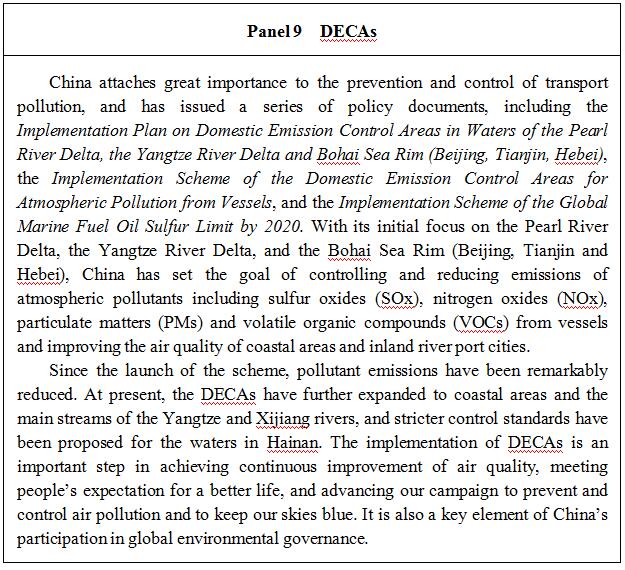
Intensifying eco-environmental protection and restoration. China has strictly enforced the red lines for protecting the ecosystems and has put in place a system for protecting and restoring ecosystems. In building transport infrastructure, it has adopted a model of "avoidance, protection and restoration", and promoted eco-friendly route planning and site selection and design. Particular efforts have been made to avoid farmland, forestland, wetland and other types of territorial space with key eco-environmental functions.
China has carried out afforestation programs along railways, highways and waterways to improve eco-environmental functions and landscape quality. In railway and highway construction projects it makes provision for wildlife corridors. The wildlife corridors built on the Qinghai-Tibet Railway have guaranteed the safe migration of Tibetan antelopes and the movement of other plateau animals. In the construction of ports and the renovation of waterways, China has focused on reducing impacts on aquatic ecology and life, building fishways and facilitating fish migration. It has implemented more than 50 million square meters of eco-environmental restoration along highways and ports.
The country has also addressed the problems of illegal docks and sand mining along the Yangtze River. By the end of 2019, it had closed or rectified 1,361 illegal docks, improving the eco-environment and ensuring flood control, water supply and navigational safety along the river.
3. Strengthening Safety Management and Emergency Response
Upholding the sanctity of human life, China has improved the capacity of the transport industry to deal with public emergencies and in particular major public health emergencies, strengthened safety management and emergency response, and coordinated development and safety, so as to provide safe transport to the public and support economic and social development.
Traffic safety management has significantly improved. Putting prevention first and adopting a comprehensive approach, China has further enhanced the system for ensuring safe transport, and improved the mechanism for controlling workplace risks and removing hidden dangers, with the goal of preventing serious and major traffic accidents and ensuring workplace safety.
No major railway accidents have occurred since 2012. In 2019, railway accident fatalities had dropped by 46.1 percent compared with 2012, the death rate per billion tonne-km by 53.8 percent; the number of serious and major traffic accidents on ordinary roads had lowered by 55.9 percent, and the number of fatalities by 60 percent. In water traffic, there were no serious accidents in 2019, and the number of serious accidents and deaths both decreased by 68.5 percent and 69.4 percent respectively compared with 2012. Civil aviation has achieved a new safety record of almost 81 million hours of continuous safe flight in 112 months.
Emergency response has markedly improved. China has strengthened emergency response capacity, prevented and defused major safety risks in a timely manner, and effectively responded to disasters and accidents of all kinds. It has carried out projects to secure safety of high-speed railways, built a security system combining manpower, equipment and technology, and improved the security conditions along high-speed railway lines, removing 64,000 potential risks from the routes. Efforts have also been made to improve the safety of standard rail lines. The country has carried out safety and security projects covering 889,000 km of roads at or above the township level, renovated 47,000 unsafe bridges, and effectively disciplined the operation of transport vehicles.
China has strengthened maritime rescue and reinforced emergency response to major offshore oil spills. It has established a fast and efficient approach to maritime search and rescue that follows unified government leadership with the main responsibility on local authorities, and enlists help from both professional forces and the public in line with the principle of proximity and convenience. China is now equipped with more than 70 professional rescue vessels, more than 120 salvage vessels, more than 20 specialized rescue aircraft, and more than 20 emergency rescue teams. It has built a maritime search and rescue capability composed of professional rescue and salvage forces, the armed forces, government forces and social forces. From 2012 to 2019, the government organized 16,000 maritime search and rescue operations, dispatching 72,000 vessels and 2,780 aircraft, and rescued 11,000 vessels and 122,000 people in distress, with a success rate of 96.2 percent.
The capacity to deal with public emergencies has distinctly improved. China has enhanced its emergency response systems and capabilities, and has responded rationally and efficiently to various public emergencies. After Covid-19 struck, the Chinese government made resolute decisions to block the transmission of the virus and ensure the continuity of the transport network, the channels for emergency transport, and the transport of goods and materials essential for work and daily life. It introduced a series of timely policies and measures:
ensuring the rapid handling and delivery of emergency supplies by rail;
prioritizing and expediting free road access for emergency transport vehicles;
giving priority to emergency transport waterway vessels in passing through locks, being piloted, anchoring and docking;
allowing each Chinese airline to operate only one route per country with no more than one flight per week;
matching supply and demand between air transport enterprises and international trade and foreign-funded enterprises; and
opening fast postal channels.
These measures stopped any spread of the virus by means of transport and ensured the availability of emergency supplies and daily necessities, providing strong support for the all-out war against the epidemic.
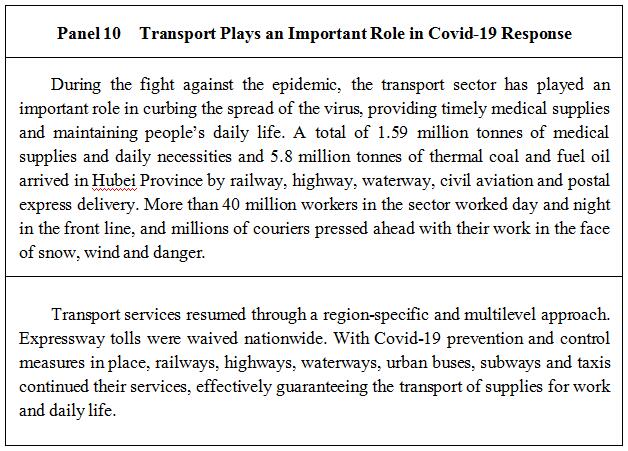
V. Building a Global Community of Transport for All
Pursuing a mutually beneficial strategy of opening up, China expands cooperation with other countries in the field of transport, actively promotes global connectivity and engages in global transport governance. It earnestly fulfills its international responsibilities and obligations and pursues win-win results and common development through cooperation in wider fields and at higher levels, contributing to building a global community of transport for all, and promoting a global community of shared future.
1. Contributing to Belt and Road Cooperation
The Belt and Road Initiative embodies great dreams. Following the principles of extensive consultation, joint contribution and shared benefits, China joins hands with other countries to accelerate cooperation in infrastructure connectivity and build a high-quality development path that is inclusive and beneficial to all – a road of peace, cooperation and prosperity.
Promoting connectivity of transport infrastructure. China recognizes the importance of transport in promoting global connectivity and shared prosperity, and thus strengthens win-win cooperation with other countries in transport connectivity. Steady progress has been achieved in cooperation on the Pakistan Main Line 1 (ML-1) upgrading project, the China-Nepal Cross-border Railway, the China-Laos Railway, the China-Thailand Railway, and the Jakarta-Bandung High-speed Rail. With the joint efforts of Chinese enterprises and their international partners, the Mombasa-Nairobi Railway, the Addis Ababa-Djibouti Railway, and the Orange Line metro train project in Lahore, Pakistan have been completed.
More than 31,000 China Railway Express Trains have made trans-continental voyages to Europe, reaching 92 cities in 21 European countries.
Cooperation between China and relevant countries has brought a number of road and bridge projects to completion, including the Havelian-
Thakot section of the Karakoram Highway and the Sukkur-Multan section of the Peshawar-Karachi Motorway, the Kunming-Bangkok Expressway, the Heihe-Blagoveshchensk Highway Bridge, the Tongjiang-Nizhneleninskoye Railway Bridge and other road and bridge projects.
China has participated in the construction and operation of the Port of Piraeus in Greece, the Port of Colombo in Sri Lanka, the Gwadar Port in Pakistan and other overseas ports. With the active participation and joint efforts of the countries concerned, a connectivity framework consisting of six corridors, six routes and multiple countries and ports has taken shape.
A comprehensive, multilevel infrastructure network with railways, highways, shipping and aviation at its core is forming rapidly. As a result, the costs of cross-regional trade and goods movement have been gradually reduced, facilitating the orderly flow and optimal allocation of resources and other production factors across regions.
Facilitating international transport. China actively promotes the coordination of policies, rules and standards among countries so as to provide institutional support for connectivity. Under the framework of Belt and Road cooperation, it has signed 22 agreements on international road transport with 19 countries, reached bilateral agreements with Belgium, the UAE, and France on mutual recognition and exchange of motor vehicle driving licenses, and concluded 70 bilateral or regional shipping agreements with 66 countries and regions, with its shipping services covering all costal countries along the Belt and Road.
China has also signed agreements with 26 countries and regions on unilateral or mutual recognition of seafarer's certificate of competency, and signed a memorandum of understanding on electronic certificates with Singapore to facilitate customs clearance of ships and the application of electronic certificates in the global shipping industry. An international railway cooperation mechanism has been established for China Railway Express to Europe, and China has signed postal cooperation agreements with 22 countries, realizing regular outbound mail traffic of China Railway Express.
China has signed bilateral intergovernmental agreements on air transport with 100 countries. By the end of 2019, Chinese and foreign airlines were operating air routes in China reaching 54 countries, with 6,846 round-trip flights every week. China has signed regional air transport agreements with ASEAN and the European Union.
China has established a cooperation mechanism for maritime search and rescue with Japan, the Republic of Korea, and Russia, and signed a departmental memorandum of understanding on maritime search and rescue with the National Search and Rescue Agency of Indonesia.
Thanks to these measures, China can enjoy closer cooperation, more convenient exchanges, and more shared interests with other countries along the Belt and Road.
2. Promoting Reform of Global Transport Governance
Currently, global transport governance faces a series of new challenges. To better facilitate and support global development, it urgently needs reform and innovation. China firmly supports multilateralism, actively promotes the evolution of the global transport governance system, and contributes China's vision and approach to global transport governance.
Participating in global transport governance. As a major country that shoulders its international responsibilities and obligations, China has become a party to nearly 120 multilateral agreements on transport; it has taken an active part in the UN Economic and Social Commission for Asia and the Pacific (ESCAP), the Organisation for Cooperation between Railways (OSJD), the International Union of Railways (UIC), the World Road Association (PIARC), the International Transport Forum (ITF), the International Maritime Organization (IMO), the International Civil Aviation Organization (ICAO), the Universal Postal Union (UPU) and other international organizations. China has been reelected as a Category (a) Council member of the IMO and member of the councils of the UPU. It has hosted the World Transport Convention and other international conferences.
China is committed to undertaking all transport-related actions under the framework of the UN 2030 Agenda for Sustainable Development. It works with other developing countries to promote reform of global governance for sustainable transport, with the goal of creating a favorable international environment for developing countries.
Contributing to global climate governance. China attaches great importance to tackling climate change, actively undertakes international responsibilities and obligations that are commensurate with its stage of development and national conditions, and enforces a national strategy to proactively respond to climate change. It has played a leading role in formulating and implementing IMO's initial strategy on the reduction of greenhouse gas (GHG) emissions from ships, and worked hard to safeguard the interests of developing countries during the formulation and implementation of the market-based measure – Carbon Offsetting and Reduction Scheme for International Aviation. China strives for the establishment of a fair and rational global climate governance system directed towards cooperation and win-win results, with the goal of contributing to global eco-environmental progress and sustainable development.
3. Strengthening International Exchanges and Cooperation
In the spirit of equality and mutually beneficial cooperation, China seeks closer and broader cooperation with other countries on transport, to facilitate an open world economy.
Broadening the global network of partnerships. Through mechanisms such as the Transport Cooperation Sub-Committee of the Committee for Regular Meetings between Chinese and Russian Heads of Government, the China-US Transportation Forum, and the China-CEEC Transport Ministers' Meeting, China furthers cooperation in sustainable development of transport and plays a constructive role in building a new model of international relations.
Adhering to the principles of amity, sincerity, mutual benefit, and inclusiveness in its relations with its neighbors, China strengthens its cooperation with neighboring countries in transport. The following mechanisms have been established: the China-Japan-Korea Ministerial Conference on Transport and Logistics, the Meeting of SCO Ministers of Transport, the ASEAN and China Transport Ministers Meeting, the Joint Committee on Coordination of Commercial Navigation on Lancang-Mekong River among China, Laos, Myanmar and Thailand, mechanisms for the use and management of China-Russia and China-DPRK transboundary waterways, the Asia-Pacific Heads of Maritime Safety Agencies (APHoMSA) forum, and the China-ASEAN Maritime Consultation Mechanism. China has participated in transport cooperation under the Greater Mekong Subregion (GMS), the Central Asia Regional Economic Cooperation (CAREC) and other frameworks, contributing substantially to regional economic development.
Guided by the principle of pursuing the greater good and shared interests, China actively engages in international programs on enhancing maritime capability and technological cooperation, and provides support and aid for other developing countries in infrastructure construction, planning and capacity building. Through broad and in-depth exchanges and cooperation, China has broken new ground in opening up featuring mutually beneficial market-based cooperation, experience-sharing and mutual learning.
Engaging in international cooperation in fighting Covid-19. The coronavirus is a common foe of all of humanity. China strengthens transport cooperation in Covid-19 prevention and control with other countries and promotes a global community of health for all. At China's initiative, the IMO recommended and forwarded a number of protocols from China to its 174 member states and relevant international organizations, including Guidelines for Covid-19 Prevention and Control for Seafarers on Board Vessels and Guidelines for Covid-19 Prevention and Control for Ports and Their Frontline Staff. The Civil Aviation Administration of China shared with its counterparts in more than 40 countries Preventing Spread of Coronavirus Disease 2019 (COVID-19) Guideline for Airlines and Preventing Spread of Coronavirus Disease 2019 (COVID-19) Guideline for Airports. Via the UPU, China Post shared the Handbook for New Coronavirus Prevention and Control with 192 member states of the union.
China attended the Special Session of the Eighth China-Japan-Korea Ministerial Conference on Transport and Logistics, the China-ASEAN Transport Ministers' Special Meeting on Covid-19, and the 19th China-ASEAN Transport Ministers' Meeting via video links, and joint statements were issued after the events.
China has established domestic fast channels for the transport of materials to assist in the battle against Covid-19, and set up special task forces for international logistics. Through multimodal methods such as multi-stop chartered flights, commercial flights, sea-land multimodal freight and China Railway Express to Europe, it provides full support for transporting aid materials. So far, 294 batches of supplies have been provided to 150 countries and 7 international organizations, and 35 teams totaling 262 medical experts have been dispatched to aid 33 countries.
VI. Future Prospects for China's Transport
The 19th CPC National Congress laid out the goals for realizing basic socialist modernization by 2035 and developing China into a great modern socialist country by the middle of the century. The Fifth Plenary Session of the 19th CPC Central Committee proposed that we should accelerate the effort to build China into a country with a strong transport industry, which would bring in a period of good opportunities for the sector's development.
A high-quality transport industry is a matter of urgency. Decisive progress has been made in China's endeavors to secure a decisive victory in building a moderately prosperous society in all respects. The country has entered a new stage of development and worked to put into practice the new development philosophy, with a higher requirement and providing more room for transport to contribute to the new development dynamic. The Chinese people's expectations of a better life have been growing in a multi-tiered and multi-faceted way, producing stronger and more diverse demands for transport services.
A new round of technological revolution and industrial transformation is gaining momentum and bringing tremendous changes to transport. Meanwhile, China is faced with a more complex international environment and increasing instability and uncertainty. The worldwide spread of Covid-19 has led to a level of profound worldwide change unseen in a century. Unilateralism, protectionism and hegemonism have seriously impeded international industry and supply chains. Climate change has posed real and potential threats to eco-environmental security and economic and social development.
Facing these changes in the international and domestic situation, China is moving faster in developing a national comprehensive and multidimensional traffic network, and reinforcing its strength in transport to satisfy the needs of its people, ensure adequate support for transport, and become a world leader in this field. They involve both opportunities and challenges.
China will adapt to changes in work and daily life, develop transport services that fully respond to public needs, and improve the efficiency and service quality of a comprehensive transport network. To serve the exploitation and protection of its land resources, and to ensure coordinated development between rural and urban areas and between regions, China will improve its all-round transport support capabilities, maintain a future-oriented approach to the development of its transport infrastructure, and optimize the leading role of transport in bolstering economic and social development. To serve high-quality economic development, China will transform the growth model of its transport industry, pursue safe, intelligent and green transport, improve its capacity in safety management and emergency response and rescue, and modernize its transport governance. To support opening up on all fronts, China will strengthen the connectivity of transport infrastructure and improve the globally-oriented network of transport services.
China moves faster to become a world leader in transport. In its endeavors to build a high-quality transport system fit for a new stage of development, China is committed to people-centered development, and pursues supply-side structural reform as its main task. Giving priority to transport in future plans, China will shift its focus from speed and scale to quality and efficiency, from independent initiatives to integrated multimodal development, and from traditional drivers to innovative forces. Our country will build a modern comprehensive transport system that is safe, convenient, efficient, green and economical, equipped with world-class facilities, technology, management and services.
By 2035, China will have built up significant strength in transport. A modern comprehensive transport system will be in place to substantially improve public satisfaction levels and better support national modernization. Equipped with an advanced express network, sound trunk network, and extensive basic network, the system will raise the coordinated transport development in urban and rural areas to new heights.
The National 1-2-3 Travel Circle (one hour to commute in cities, two hours to travel within city clusters, and three hours to travel between major domestic cities) and the Global 1-2-3 Logistics Circle (one day to deliver within China, two days to deliver to neighboring countries, and three days to deliver to major global cities) will take initial shape, providing convenient combined transport of passengers, and economical and efficient multimodal transport of goods. China will make marked progress in developing intelligent, safe, green and shared transport, easing urban traffic congestion, and creating a barrier-free travel system.
The country will establish a sci-tech innovation system for transport, develop advanced and safe key equipment, train high-caliber professionals, and create a sound market environment. China will achieve the basic modernization of its transport governance. Its international competitiveness and influence in transport will be improved markedly. China will make all-round progress in transport to meet the people's growing expectation for a better life and provide powerful support for achieving basic socialist modernization.
Conclusion
China is engaged in an all-out effort to build a great modern socialist country. Transport will play a stronger part in leading economic and social development. China will implement the new development strategy and develop safe, convenient, efficient, green and economical transport to lay a solid foundation for achieving basic socialist modernization by 2035 and becoming a great modern socialist country in all respects by the middle of the century.
At present, the world is facing challenges from the Covid-19 pandemic and economic recession. Transport can play an important role in binding countries together and promoting economic growth during this difficult time. Upholding the vision of a global community of shared future, China will continue to implement the UN 2030 Agenda for Sustainable Development and strengthen international exchanges and cooperation on transport. China will work with all other countries to promote global connectivity and stronger people-to-people ties, and make a greater contribution to building a better world.
























